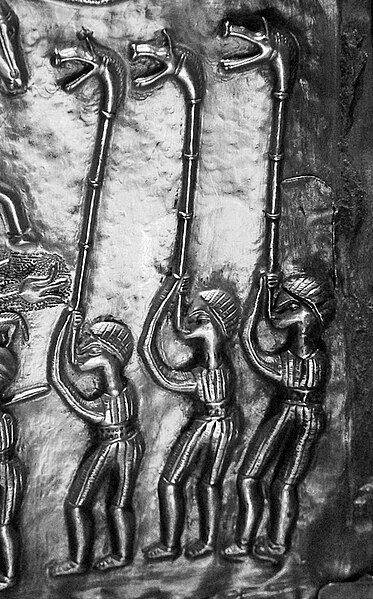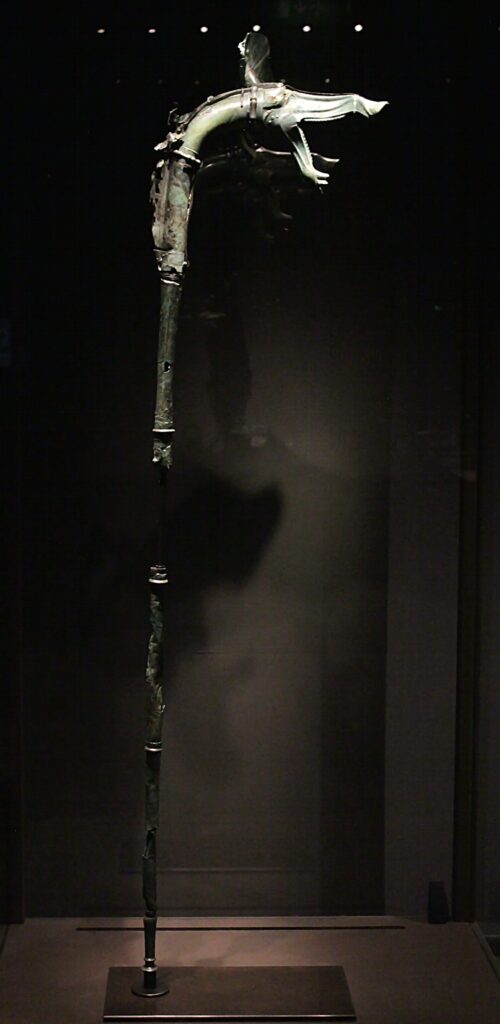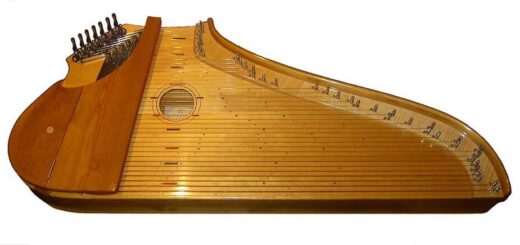Carnyx – Echoes of the Iron Age

When we think of ancient instruments, our minds often drift to the lyres of Greece or the flutes of Egypt. But in the misty hills of Iron Age Europe, a far more dramatic sound once rang out: the blaring, warlike roar of the Carnyx.
What is a Carnyx?
The Carnyx (pronounced car-niks) was no ordinary horn. Towering up to 12 feet high and often shaped like a fierce animal’s head, usually a boar or dragon, it was the battle trumpet of the ancient Celts and other tribes of Northern and Western Europe. Played vertically, with the bell above the player’s head, it wasn’t just an instrument; it was a statement.
Made of bronze and often ornately decorated, the Carnyx wasn’t only about sound. It was designed to intimidate. When blown into, it emitted a wild, brassy, almost howling tone that could echo across valleys and send a chill down the spine of anyone unfortunate enough to be on the receiving end.

Three carnyx players depicted on plate E of the Gundestrup cauldron. – Creative Commons | Author: Bloodofox – Source: https://commons.wikimedia.org/wiki/File:Figures_with_horns_on_the_Gundestrup_Cauldron.jpg
The Sound of War
Used between roughly 300 BCE and 200 CE, the Carnyx was most famously employed in battle. Roman writers, including the historian Dio Cassius, wrote about its terrifying presence on the battlefield. When multiple Carnyces were played together, they created a chaotic wall of sound designed to psych up Celtic warriors and demoralize their enemies.
And it wasn’t just noise. These instruments may have had moving parts—some had tongues or jaws in the bell that rattled when played, adding an eerie, animalistic growl to the already spine-tingling sound.

The carnyx of Tintignac, discovered in Corrèze, France. – Creative Commons | Author: Claude Valette – Source: https://commons.wikimedia.org/wiki/File:CarnyxDeTintignac1.jpg
Rediscovery and Revival
For centuries, the Carnyx was lost to time. But in the early 2000s, a remarkable archaeological find in Deskford, Scotland unearthed the most complete Carnyx ever discovered: the Deskford Carnyx. From this, modern craftsmen and musicians were able to reconstruct working replicas.
One of the most famous is the Celtic Carnyx reconstructed by John Kenny, a trombonist and music archaeologist. His performances bring the haunting call of the Carnyx back to life—evoking both awe and a sense of ancient mystery.

A carnyx found at Tintignac – Creative Commons | Author: Claude Valette – Source: https://commons.wikimedia.org/wiki/File:CarnyxDeTintignac3.jpg
A Symbol of Identity
Today, the Carnyx has come to symbolize Celtic heritage and resilience. It appears in reenactments, cultural festivals, and even modern music compositions. Though its roar once echoed across battlefields, it now sings again in concert halls, documentaries, and museums.
In an age of electronic everything, the primal sound of the Carnyx reminds us of the power of raw breath, bronze, and bold imagination.
Want to Hear It?
Curious about what a Carnyx actually sounds like? Search for “John Kenny Carnyx” on YouTube, you might be surprised by how modern and otherworldly this ancient instrument can sound.
References:
https://en.wikipedia.org/wiki/Carnyx










